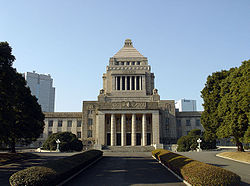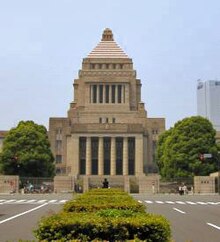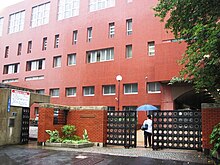User:Darkslime/Chiyoda-ku
Chiyoda
千代田 | |
|---|---|
| 千代田区 · Chiyoda City | |
 The National Diet Building, Chiyoda, Tokyo | |
 Location of Chiyoda in Tokyo | |
| Country | Japan |
| Region | Kantō |
| Prefecture | Tokyo |
| Area | |
| • Total | 11.64 km2 (4.49 sq mi) |
| Population (2007) | |
| • Total | 45,543 |
| • Density | 3,912/km2 (10,130/sq mi) |
| Time zone | UTC+09:00 (JST) |
Chiyoda (千代田区, Chiyoda-ku) is one of the 23 special wards in central Tokyo, Japan. In English, it is called Chiyoda City.[1] As of October 2007, the ward has an estimated population of 45,543 and a density of 3,912 persons per km², making it by far the least populated of the special wards. The total area is 11.64 km², of which the Imperial Palace takes up 12 percent.
Chiyoda consists of the Palace and a surrounding radius of about 1 kilometer. It inherited the name, literally meaning "field of a thousand generations," from Chiyoda Castle (the other name of Edo Castle). Many government institutions, such as the Diet, Prime Minister's residence, and Supreme Court, are located in Chiyoda, as are Tokyo landmarks such as Yasukuni Shrine, Tokyo Station, and the Budokan. Fifteen embassies are located in Chiyoda.
History[edit]
The Chiyoda ward was created on March 15, 1947 by the unification of Kanda Ward (the northeast corner of present-day Chiyoda, around Akihabara Station) and Kōjimachi Ward (comprising the rest of Chiyoda). It has been a site of a number of historical events.
- In 1860, the assassination of Ii Naosuke took place outside the Sakurada Gate of the Imperial Palace.
- In 1932, assassins attacked and killed prime minister Inukai Tsuyoshi.
- In 1936, an attempted coup d'état, the February 26 Incident, occurred.
- In 1995, members of Aum Shinrikyo carried out the Sarin gas attack on the Tokyo subway.
Geography[edit]
Chiyoda is located at the very heart of central Tokyo. The central area of the ward is furthermore occupied by the Imperial Palace. The east side of the ward, bordering Chūō, is the location of Tokyo Station. The south side, bordering Minato, encompasses Hibiya Park and the National Diet Building. It is almost exclusively occupied by administrations and agencies. The west and northwest are primarily upper class residential; the Yasukuni Shrine is also there. To the north and northeast are several residential neighborhoods and the Akihabara commercial district.
Politics and government[edit]


Local government[edit]
Chiyoda is run by a city assembly of 25 elected members. The current mayor is Masami Ishikawa, an independent.
National representation[edit]
The ward is also home to the Diet of Japan, the Supreme Court of Japan and the residence of the Prime Minister of Japan and is the political nerve center of Japan.
International representation[edit]
The Embassy of the United Kingdom is in Ichibancho in Chiyoda.[2] The Embassy of Belgium is located in the Nibancho area of Kojimachi, Chiyoda. The embassy has been in Kojimachi since 1902 and the Nibancho area since 1928. Until around 2009 the Belgian embassy is temporarily in Shibakoen, Minato due to remodeling of the embassy in Chiyoda.[3] The Embassy of Ireland is located in the Kōjimachi area of Chiyoda.[4] The Embassy of Israel is located in Niban-cho in Chiyoda.[5]
Cityscape[edit]
On December 31, 2001 Chiyoda had 6,572 buildings which were four stories or taller.[1]
Some of the districts in Chiyoda are actually not inhabited, either because they are parks (Hibiya Koen), because they consist only of office buildings (Otemachi, Marunouchi...), and/or because they are extremely small. The area on the Eastern side of the Akihabara station is the location of several districts that cover at most a few buildings. Kanda-Hanaokachō is for example more or less limited to the building of Yodobashi Camera. Tackling the addressing system in the Kanda area can be particularly cumbersome for non-locals. However, the addressing system is currently being modernized.[citation needed]
Kōjimachi Area[edit]
- Kōjimachi Area (麹町地区), former Kojimachi ward
- The Banchō (番町) area (actually consisting of six neighborhoods, from Ichibancho to Rokubanchō), an upper class residential area, home of the embassies of Belgium, the UK and Israel.
- Chiyoda (千代田) - "1 Chiyoda, Chiyoda-ku" is the official address of the Imperial Palace
- Fujimi (富士見), location of the Philippines embassy as well as several schools
- Hayabusachō (隼町) - Houses the Supreme Court of Japan and the National Theater.
- Hibiya Kōen (日比谷) - Address for the Hibiya Park, a large park south of the Imperial Palace.
- Hirakawachō (平河町)
- Iidabashi (飯田橋)
- Kasumigaseki (霞ヶ関) - The nerve center of Japan's administrative agencies.
- Kioichō (紀尾井町) - The name, ki-o-i, is a three-kanji acronym consisting of one kanji each from the names of the Kishū Domain, Owari Domain, and Ii clan, whose daimyo residences were here during the Edo period
- Kitanomaru Kōen (北の丸公園), location of the Kitanomaru Park, North of the imperial palace, location of the Budokan.
- Kōjimachi (麹町) - Older residential and commercial neighborhood on the west side of the Imperial Palace, home to the embassy of Ireland
- Kōkyo Gaien - large open gardens in front of the Imperial palace
- Kudanminami (九段南) and Kudankita (九段北) districts, around the station of Kudanshita (九段下) - Northwest side of the Imperial Palace, home to Yasukuni Shrine.
- Marunouchi (丸の内) - Located between Tokyo Station and the Imperial Palace, one of Tokyo's traditional commercial centers.
- Nagatachō (永田町) - The location of the Diet of Japan; also houses the Hie Shrine.
- Ōtemachi (大手町) - North of Marunouchi, a district of key financial Japanese institutions and major national newspapers.
- Uchisaiwaichō (内幸町), close to the Hibiya Park, location of the Imperial Hotel, as well as head offices of banks (especially Mizuho Financial Group).
- Yūrakuchō (有楽町) - South of Marunouchi, part of the Tokyo Station business district.
Kanda Area[edit]
- Kanda Area (神田地区), former Kanda Ward. Soto-Kanda, at the northern corner of the ward, home to the famous Akihabara electronics district.
|
|
|
|
|
There are many smaller neighborhoods of the Kanda area, for which a modernization of the addressing system has not been enforced yet. All officially start with the prefix "Kanda-", but it is sometimes omitted in daily life. Note that Iwamotochō and Kanda-Iwamotochō are different districts (as is the case for Kajichō and Kanda-Kajichō)
Economy[edit]

On October 1, 2001 Chiyoda had 36,233 business establishments with 888,149 employees.[1]
Bungeishunjū,[6] Calbee,[7] Datam Polystar,[8] Hakusensha,[9] Japan Freight Railway Company,[10] Japan Post Holdings,[11] KDDI,[12] Konica Minolta,[13] Mitsubishi Estate,[14] Mitsubishi UFJ Financial Group,[15] Mizuho Financial Group,[16] New Otani,[17] NTT docomo,[18] Stack Ltd. (0verflow),[19] Seven & i Holdings,[20] Shinsei Bank,[21] Shogakukan,[22] Shueisha,[23] Toho,[24] Yamazaki Baking Company (incl. Vie de France),[25][26] Mazda has an office in Chiyoda.[27] and Yomiuri Shimbun are headquartered in Chiyoda.[28]
Foreign operations[edit]
The Japan division of Sunoco is headquartered in the Trusty Kojimachi Building in Chiyoda.[29] AMI Japan, a subsidiary of American Megatrends, is in Chiyoda.[30] Hewlett-Packard Japan is headquartered in Chiyoda.[31] Chloé Japan is headquartered in the Hanzomon First Building in Chiyoda.[32] Sidley Austin's Japan office is in the Marunouchi Building.[33]
Former operations[edit]
Japanese companies which formerly had their headquarters in Chiyoda include All Nippon Airways,[34] Bandai Visual,[35] Galaxy Airlines,[36] Japan Airlines,[37] Japan Asia Airways,[37] Mitsui Chemicals,[38] Nippon Cargo Airlines,[39] and Yamato Life.[40] In 1998 Fujitsu operated a branch office in Chiyoda.[41] Prior to its disestablishment, At one point Cantor Fitzgerald had an office in Chiyoda.[42]
Attractions[edit]


- Akihabara
- Hibiya Park
- Imperial Palace
- Kitanomaru Park
- National Diet Building
- Nippon Budokan
- Tokyo International Forum
- Tokyo Station
- Tokyo Takarazuka Theater
Transportation[edit]
Chiyoda is home to the massive Tokyo station, with a multitude of subways, railways and long-distance services.
Points of historical interest[edit]
-
Site of Haniwa Hokinoichi Wagaku kōdansho
(Sanbanchō) -
Site of home of Sano Zenzaemon
(Sanbanchō) -
lighthouse of Kudan
Education[edit]
Primary and secondary schools[edit]

On May 1, 2003 Chiyoda had eight elementary schools with 2,647 students and five junior high schools with 1,123 students.[1] Public elementary and junior high schools in Chiyoda are operated by the Chiyoda Board of Education. Public high schools are operated by the Tokyo Metropolitan Government Board of Education.
Colleges and universities[edit]
Hitotsubashi University's Graduate School of International Corporate Strategy is located in the National Center of Sciences in Hitotsubashi.
Both of the Sophia University Campuses are in western Chiyoda. The main Yotsuya campus lies adjecent to Yotsuya Station and the Ichigaya Campus just south of Ichigaya Station.
Libraries[edit]
Chiyoda operates four public libraries; they are the Chiyoda Library, Yobancho Library, Shohei Library, and Kanda Library. Tokyo operates the Tokyo Metropolitan Library Hibiya Library. The Japanese government operates the National Diet Library and the National Archives. Ishikawa Enterprise Foundation Ochanomizu Library is a nearby private library.[43]
Parks and recreation[edit]
East Imperial Garden, located on the eastern portion of the Tokyo Imperial Palace grounds and housing the castle tower and the outer defense positions of the former Edo Castle, opened to the public in 1968. Kitanomaru Park, located on Edo Castle's former northern section, has the Tokyo National Museum of Modern Art and the Nippon Budokan, a venue for performances. Chidorigafuchi Boat Arena and Chidorigafuchi Moat Path includes a waterway for boats. National Diet Building Park, located adjacent to the Diet Building and divided in two by a street, includes American dogwoods planted to symbolize the relations between the United States an Japan. Hibiya Park, Japan's first western-style park, includes restaurants, open-air concert halls, and tennis courts. Imperial Palace Outer Garden, in the front of Nijubashi Bridge, serves as a jogging trail and a tourist site.[44]
References[edit]
- ^ a b c d "Profile." City of Chiyoda. Retrieved on December 28, 2008.
- ^ "Contact us." Embassy of the United Kingdom in Japan. Retrieved on December 28, 2008.
- ^ "Welcome." Embassy of Belgium in Tokyo. Retrieved on December 28, 2008.
- ^ "Ireland in Japan." Department of Foreign Affairs. Retrieved on December 28, 2008.
- ^ "Welcome to the website of the Israel Embassy in Tokyo." Israel Diplomatic Network. Retrieved on December 28, 2008.
- ^ "会社概要." Bungeishunjū. Retrieved on October 1, 2009.
- ^ "Corporate Information." Calbee. Retrieved on March 27, 2010.
- ^ "About Us." Datam Polystar. Retrieved on December 28, 2008.
- ^ "Corporate Profile." Hakusensha. Retrieved on October 1, 2009.
- ^ "Corporate Overview." Japan Freight Railway Company. Retrieved on March 27, 2010.
- ^ "About Japan Post." Japan Post Holdings. Retrieved on April 24, 2010.
- ^ "Corporate Data." KDDI. Retrieved on February 21, 2010.
- ^ "Company Overview." Konica Minolta. Retrieved on May 12, 2009.
- ^ "Corporate Data." Mitsubishi Estate. Retrieved on March 7, 2010.
- ^ "About MUFG." Mitsubishi UFJ Financial Group. Retrieved on December 7, 2009.
- ^ "Map." Mizuho Financial Group. Retrieved on December 28, 2008.
- ^ "Hotel Overview." New Otani. Retrieved on April 3, 2009.
- ^ "Headquarters Location." NTT docomo. Retrieved on March 7, 2010.
- ^ "About Us" (in Japanese). Stack Ltd. Retrieved 2009-11-01.
- ^ "Office Map." Seven & i Holdings. Retrieved on January 13, 2009.
- ^ "Head Office." Shinsei Bank. Retrieved on May 19, 2009.
- ^ "所在地." Shogakukan. Retrieved on October 1, 2009.
- ^ "会社案内." Shueisha. Retrieved on October 1, 2009.
- ^ "会社の沿革." Toho. Retrieved on February 26, 2010. "2005年4月 東宝本社を東宝日比谷ビル(東京都千代田区有楽町一丁目2-2)に移転。"
- ^ "Company Profile." Yamazaki Baking Company Limited. Retrieved on May 19, 2009.
- ^ "会社概要." Vie de France. Retrieved on May 18, 2009.
- ^ "Offices." Mazda. Retrieved on October 29, 2009.
- ^ "組織体制." Yomiuri Shimbun. Retrieved on March 5, 2010.
- ^ "Company Details." Sunoco Japan. Retrieved on November 10, 2008.
- ^ "International Offices." American Megatrends. Retrieved on May 6, 2009.
- ^ "Headquarters." Hewlett Packard. Retrieved on July 23, 2009.
- ^ "Chloé Offices." Chloé. Retrieved on 23 August 2009.
- ^ "Tokyo." Sidley Austin. Retrieved on December 17, 2009.
- ^ "World Airline Directory." Flight International. March 30, 1985. 50." Retrieved on June 17, 2009.
- ^ "History." Bandai Visual. Retrieved on March 16, 2010.
- ^ "会社概要." Galaxy Airlines. May 1, 2006. Retrieved on May 20, 2009.
- ^ a b "World Airline Directory." Flight International. March 30, 1985. 88." Retrieved on June 17, 2009.
- ^ "What's New." Mitsui Chemicals. June 5, 2001. Retrieved on February 18, 2010.
- ^ "Chapter 3. On the path to becoming a member of the incumbent carrier group." Nippon Cargo Airlines. 59. Retrieved on February 18, 2010.
- ^ "会社概要." Yamato Life. February 5, 2005. Retrieved on January 20, 2010.
- ^ "Company Profile." Fujitsu. January 19, 1998. Retrieved on May 19, 2009.
- ^ "office locations." Cantor Fitzgerald. March 4, 2000. Retrieved on October 4, 2009.
- ^ http://www.city.chiyoda.tokyo.jp/english/e-guide/libraries.html
- ^ "Parks in Chiyoda." City of Chiyoda. Retrieved on December 28, 2008.




